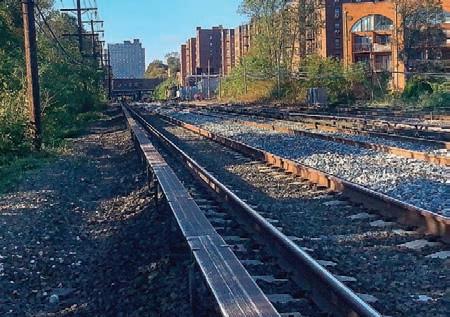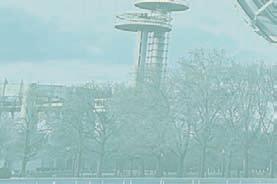
7 minute read
The LIRR’s deadliest crash helped spur eformrail r
1950 TRIUMPH OVER TRAGEDY Holiday horror topped a terrible year
LIRR’s worst crash ever, in Kew Gardens, killed 78, helped fuel state takeover
by Michael Shain Chronicle Contributor
On Thanksgiving Eve, almost exactly 70 years ago, 78 people were killed and twice as many injured when a Long Island Rail Road express train slammed into the back of a stalled local in Kew Gardens.
It was the worst disaster in the history of the LIRR, the nation’s oldest and busiest rail line, and the catastrophic capstone to perhaps its worst year ever.
There was no shortage of people to blame.
If you never heard of the Kew Gardens LIRR crash on Nov. 22, 1950, you are hardly alone.
New Yorkers have notoriously short-term memories when it comes to tragedy and disaster.
How many have heard of the sinking the steam ferry General Slocum in the East River that killed more than 1,000 people — most of them women and children — in 1904?
Or the Malbone Steet wreck in 1918, when a BMT subway train derailed in Flatbush, killing 93 people — the deadliest subway accident in U.S. history?
Even the events of 9/11 seem to be fading with every passing year.
Nevertheless. the death toll from the 1950 LIRR crash was a shock wave that rolled through the city like deadly fog.
It was the beginning of the end for private railroads in the Northeast and led to the first steps in the creation of the MTA. It was a tragic lesson in what happens when infrastructure is neglected and safety measures shrugged.
Let’s start at the beginning.
Because it was evening rush, both LIRR trains were packed, each carrying more than 1,000 passengers.
Holiday travelers added to the load. Every seat was taken and a large-but-unknown number of people were standing in the aisles.
Just before 6:30 p.m., the operator of a Hempstead-bound train heading into Jamaica station was directed by the trackside signal lights to slow down, then stop at a spot 2,000 feet outside the Kew Gardens station. When he tried to restart the train, the brakes would not release. The 12-car train was locked in place.
Behind the Hempstead train, the operator of a train headed for Babylon was stopped as well. When the signals changed, it is theorized, the Babylon operator started up again after misreading a “proceed” light

half a mile ahead that had parkways and, later, the Long been intended for the stalled Island Expressway, was an train in front of him. easy alternative within reach
By the time the Babylon of just about everyone. train passed under the Lef- The disastrous events of ferts Avenue overpass, it was 1950 and the widespread fear traveling at 35 mph, not that the railroad was unsafe enough time to slow down only encouraged more people before slamming into the to take the car instead. Hempstead train stalled a In the wake of the Kew block from the trestle over Gardens disaster, New York Metropolitan Avenue. State started making its first
The first car of the Baby- contributions to the railroad’s lon train telescoped on operation. impact, crushing scores of “It was a fraction of what passengers to death. they get today,” said Penner.
Police said the only way The subsidies were small, but they were able to identify the marked the start of what operator’s body was by the would eventually become the LIRR-issued work glove on MTA. his right hand. Three days after the
Photos from that night crash, Gov. Thomas Dewey show the last car of the told reporters he estimated Hempstead train had been the railroad needed $50 miltossed in the air by the crash Looking west from the site of the crash toward the Lefferts Avenue Bridge. The Babylon train passed lion to get back on its feet. and come down on top of the under the overpass and could not stop in time to avoid the stalled train. PHOTO BY MICHAEL SHAIN As a result of the Kew lead car of the Babylon train. Gardens disaster, the Pennsy
Newspaper accounts of the crash blamed the signalman aboard the crossing — and the elegant, elevated agreed to take the LIRR out of were horrific. Hempstead train for failing to set out tracks on Rockaway Beach Boule- receivership and begin upgrading the
“Passengers standing in the aisles flares warning approaching trains vard originally built for the railroad line. In exchange, the state agreed the didn’t have a chance,” a conductor they were stalled. — ever since. railroad could stop paying taxes on told the Daily News. Another faulted the operator of It seems hardly a coincidence now its properties and revenues.
Doctors climbed ladders up the the Babylon train who’d misread that the LIRR, then privately owned The necessity of paying local taxes steep embankment in the dark, the signal. by the Pennsylvania Railroad, filed for had “left the [LIRR] at a permanent then squeezed into the wreckage The accident was not an isolated bankruptcy in 1949, the year before. competitive disadvantage,” according to treat the injured. Amputations incident, however. Like the then-privately owned sub- to historian Joe DeMay’s account were performed on the In fact, it was the ways, if the LIRR wanted to hike published by the Kew Gardens Hiss p o t , second horrendous- fares, it had to ask the New York torical Society. “The Long Island according ly deadly crash on State Public Service Commission for Rail Road had to compete for the to reports. the LIRR that permission, said Larry Penner, a his- public’s transportation dollars with
Rescuers year. torian and retired official of the Fed- the various New York State authoriwith acety- In February, eral Transit Administration. ties that owned and operated the lene torches two trains had “From 1918 to 1947, every time bridges, tunnels and highways.” The had to cut free collided head on they asked for an increase, it was change bought the Pennsy a few many of the at the Rockville denied,” said Penner, of Great more years of private ownership but survivors. Centre station. Neck, LI. the handwriting was on the wall.
E v e r y Thirty-two peo- After nearly 30 years without a Eventually, New York State took Queens detec- ple were killed. fare hike, “they had no capital money over the LIRR lock, stock and barrel tive on duty that In August, to invest in the system. That clearly in 1965. night was a passenger contributed to the crash.” “Gov. Rockefeller realized he had assigned to the train missed a Tragically, it was the Pennsy that a constituency on Long Island and crash site and signal and had developed the best train signal he wanted to keep them happy,” every patrol sideswiped a safety system in the country, state of Penner explained. wagon was pressed freight train the art for its time, which it deployed It helped too that President Lyninto service as an near Hun- all around the Northeast. But it never don Johnson had pushed through ambulance, the tington sta- installed the system on the Long Congress in the mid-1960s the first News reported. tion. No one was killed, Island line because it was too expen- federal aid to local public transpor-
Homes near the but 41 people went to the hospital. sive, according to Penner. tation systems. Money at last started site of the crash were commandeered The calamities of 1950 didn’t stop Ridership on the railroad was to flow. by authorities to treat victims. there. already beginning to spiral down and The agency that oversaw the LIRR
A temporary morgue was set up in In May, a fire destroyed an 1,800- the LIRR was starved for cash. was dubbed the MCTA, the Metrothe driveways of the private homes foot section of the train trestle over In the years after World War II, politan Commuter Transportation on 125th Street. Jamaica Bay, cutting off service to more people were moving out of the Authority, to reflect its new steward-
Immediately, investigations the Rockaways just before the start of city to the suburbs, no doubt. But ship of the line. began, including one by the Queens the busy summer season. along with the house in Levittown It wasn’t until two years later, after district attorney, who was looking for The LIRR never repaired it and, came an automobile. the state took over the New York City criminal liability. years later turned the bridge over to The car was king and the drive to subways too, that the name was
One of the reports that followed the city. The A train has used the bay New York City via the new state changed to simply the MTA. Q

















